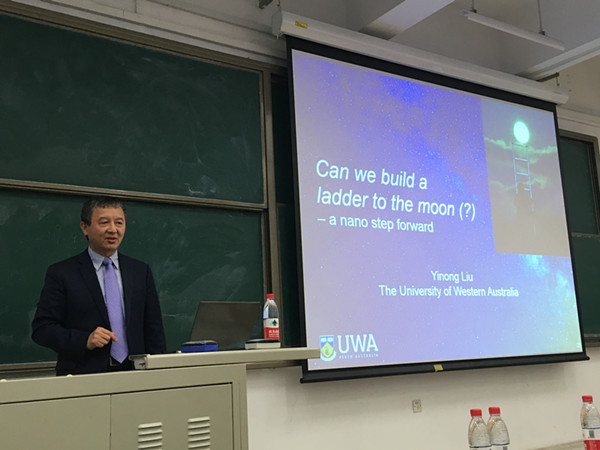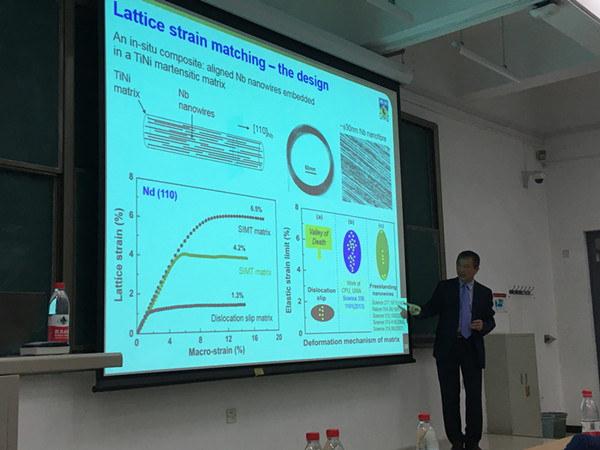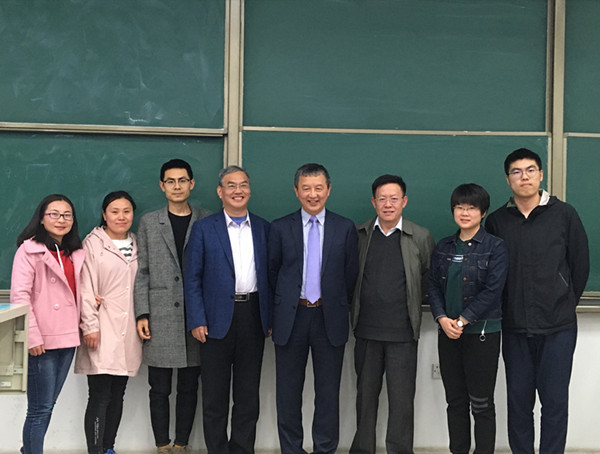News
"Meet the Master”Top Academic Forum
Winthrop Professor Liu Yinong, Vice President of The University of Western Australia, came to our university to give an academic lecture and to communicate with our teachers and students
On April 1, 2019, at 16:30 p.m., Winthrop Professor Liu Yinong, Vice President of The University of Western Australia, gave a lively and exciting academic lecture for our teachers and students in Room 304 of SIYUAN West Building, entitled "Can we build a ladder to the moon - a nano step forward". Professor Xing Shuming, Professor Han Jianmin and Vice President Ding Kejian also attended the lecture. More than 200 graduate and undergraduate students from the College of Mechanical and Electrical Engineering and the College of Science participated in the "Meet the Master" Top Academic Forum, and the scene was very warm.

On-site lecture by Winthrop Professor Liu Yinong
At the beginning of the lecture, Professor Liu Yinong first introduced the environment and development of UWA to the teachers and students. As one of the top 100 universities in the world and one of the eight famous universities in Australia, UWA has not only a strong academic strength, but also a very beautiful natural scenery. Subsequently, Professor Liu encourages students to "change the world with one idea". He mentioned that he had read a book many years ago about why we cannot build a ladder to the moon - because we do not have strong enough materials. Nanomaterials are known to exhibit exceptional properties approaching the theoretical limits of solids. It has been a long dream of scientists to transcribe these exceptional properties into bulk forms for practical application. All efforts in the past have led to no success. This situation is commonly known as the “valley of death” in materials science. Professor Liu Yinong's team proposed a new strategy based on the principle of lattice strain matching and collective atomic load transfer. The strategy utilizes the martensitic phase transforming of shape memory alloy to composite with metallic nanowires, and by doing so to induce ultra-large elastic strains of 6% and to achieve ultra-high strengths of over 6 GPa in these nanowires. This is a breakthrough to the long-standing challenge of the “valley of death” in composite design. The implication of the findings, in particular the generation of ultra-large elastic strains in solids, is much more far-reaching than achieving high strength. By imposing ultra-large elastic strains to solids, thus to alter their valence electron states, it is possible to alter the many functional properties of materials, such as magnetic, electronic, superconducting, photonic, catalytic and chemical sensing characteristics. This is an emerging frontier research, known as “elastic strain engineering”. Finally, Professor Liu briefly introduced the preliminary study in superconductivity of nanocomposites using the concept of lattice strain matching in “elastic strain engineering”.

Professor Liu Yinong is introducing the contents of the research
The "Meet the Master" Top Academic Forum broadened the students' horizons, aroused the students' interest, and the classroom rang with warm applause. At the end of the report, Professor Xing Shuming also encouraged everyone to contact and communicate with Professor Liu Yinong. He hoped that students would think positively and discover bravely in the process of study.

Professor Liu Yinong took a group photo with teachers and students
Prof. Yinong Liu obtained his PhD in 1991 from the University of Western Australia (UWA). He then worked as an Australia-France Postdoctoral Fellow at the Institut National Polytechnique de Grenoble in 1993 before returning to Australia in 1994 to start his academic career. He has served as the Head of the School of Mechanical and Chemical Engineering, the Associate Dean (International) of the Faculty of Engineering and Mathematical Sciences, and Pro-Vice Chancellor (International) at UWA. He is now a Winthrop Professor of Materials Engineering at UWA. He has worked in a number of universities outside Australia as adjunct and honorary professors, including University of Tsukuba, Universite Joseph Fourier, University de Grenoble, Katholieke Universiteit Leuven, Harbin Engineering University, Beijing University of Technology, China University of Petroleum, and Japan Society for Promotion of Science. He has served as the Chair of the National Committee of Nanoengineering of Engineers Australia and member of the College of Experts of the Australian Research Council. He is an associate editor of the journal of Shape Memory and Superelasticity, Functional Materials Letters, and a member of the editorial boards of three other international journals. His main research areas include shape memory alloys, superalloys, magnetic materials, thin film materials for MEMS applications, and functional nanomaterials and synthesis.








